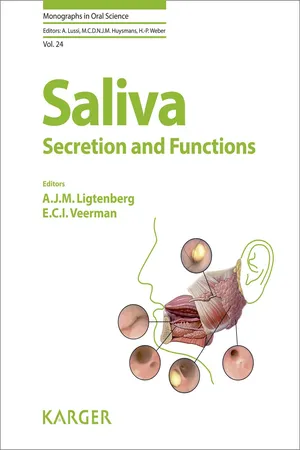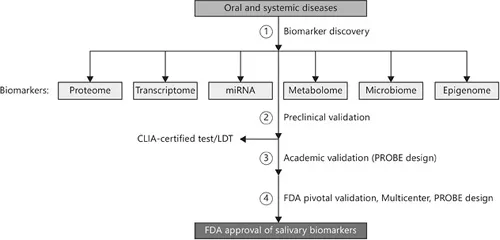![]()
Diagnostics and Disorders
Ligtenberg AJM, Veerman ECI (eds): Saliva: Secretion and Functions.
Monogr Oral Sci. Basel, Karger, 2014, vol 24, pp 88-98 (DOI: 10.1159/000358791)
______________________
Saliva Diagnostics: Utilizing Oral Fluids to Determine Health Status
Christopher A. Schafera · Jason J. Schaferb· Maha Yakoba · Patricia Limaa · Paulo Camargoa · David T.W. Wonga
aUCLA Center for Oral/Head and Neck Oncology Research, School of Dentistry, UCLA, Los Angeles, Calif., and bDepartment of Pharmacy Practice, Jefferson School of Pharmacy, Thomas Jefferson University, Philadelphia, Pa., USA
______________________
Abstract
Imagine a time where your health status could be available to you without the pain, discomfort and inconvenience of a physical examination. Distant vision of an inconceivable future or impending reality with potentially immeasurable impact? Recent advancements in the field of molecular diagnostics indicate this is not only possible, but closer than we think. Novel discoveries and substantial advancements have revealed that saliva may contain real-time information describing our overall physiological condition. Researchers are now reporting that, like blood and tissue biopsies, oral fluids could be a source of biochemical data capable of detecting certain diseases. What is even more intriguing is that this phenomenon not only applies to local disorders like oral cancer and Sjögren's syndrome, but distant pathologies like autoimmune, cardiovascular and metabolic diseases as well as viral/bacterial infections and even some cancers. These revelations have provided a foundation for the burgeoning field of salivary diagnostics and hence spurred the onset of investigations poised at deciphering the salivary milieu. This paper overviews salivary diagnostics from biomarker development to the multitude of techniques utilized in identifying saliva-based molecular indicators of disease. In doing so, we present oral fluids as an easily accessible noninvasive alternative to traditional diagnostic avenues and not just an essential component of the digestive process. Determining saliva as a credible means of evaluating health status represents a considerable leap forward in health care, one that could lead to enormous translational advantages and significant clinical opportunities.
© 2014 S. Karger AG, Basel
Molecular diagnostics is defined as the application of molecular biology techniques for the purpose of evaluating tissues and biofluids to diagnose, monitor and prognosticate disease. These techniques precisely target molecular and/or microbial entities (also called biomarkers) commonly considered as signs of specific pathologies. Identifying biomarkers at early stages of disease can expedite therapeutic interventions leading to increased survival rates, decreased suffering and low likelihood of recurrence. Current diagnostic assessments require the procurement of testing materials obtained by blood draws, biopsies or other painfully invasive procedures resulting in substantial patient discomfort and augmented health care costs. Furthermore, many disorders do not warrant diagnostic evaluations as a great deal are asymptomatic and typically remain undiagnosed until they have reached an advanced stage when damage is irreversible and treatment futile. Altogether, these statements point to the necessity for noninvasive modalities capable of distinguishing biomarkers indicative of early stage pathogenesis.
To that end, one common ambition among clinicians and basic scientists is to create a credible manner of painless predictive diagnostics. One approach is the exploration of biofluids containing analytes sensitive to our overall health status.
While primarily considered an indispensable element of early digestion, saliva is actually a heterogeneous biofluid comprised of numerous molecules along with a diverse range of microbes. Interestingly, in recent years it has become evident that these very salivary constituents become detectably altered in response to certain disease states. Even so, what is most impressive is that salivary biomarkers not only arise in correlation with oral disorders, but also those of distal tissues and organs. This suggests that oral fluids may represent a substantial reservoir of molecular and microbial information capable of communicating the onset or presence of disease throughout the body.
In consideration, a growing number of studies are focused on elucidating and developing saliva-based biomarkers indicative of both local and systemic diseases. Establishing these markers as credible could usher in a new era of patient evaluation by permitting individuals to avoid the anxiety of traditional diagnostic procedures. The potential impact of utilizing saliva as a means to ascertain the existence or likelihood of disease could markedly advance medicine, as we know it.
We begin our discussion by exploring bio-marker development and how disease-specific analytes are scrutinized prior to widespread acceptance and Food and Drug Administration (FDA) approval. Next, we delve into the vast arena of molecular and microbial analyses by describing a number of diagnostic foci. Termed ‘salivaomics’ these categories include: proteomics, epigenomics, metabolomics, immunomics, microbiome and transcriptomics. Highlighting each library as crucial to biomarker development, we review a selection of their respective biomarkers that lend credence to the continued pursuit of salivary diagnostics. Last we discuss evidence that details one possible mechanism responsible for the induction of systemic disease indicators in salivary secretions.
The discovery of discriminatory biomarkers in oral fluids epitomizes an almost incomparable breakthrough in clinical and translational science. Continuation in this area could credential saliva as an acceptable diagnostic medium, an end point with the potential to bring about a paradigm shift in the discipline of molecular diagnostics.
Biomarker Development
Challenges
In the past decade, the field of molecular diagnostics has made profound leaps forward in bio-marker discovery and the development of clinically applicable diagnostic techniques. However, definitive diagnoses can be difficult to achieve based solely on the detection of biomarkers and usually require affirmation by the employment of more traditional and often painful clinical procedures. These obstacles, among other limitations, challenge diagnosticians in their ongoing quest to establish reliable markers of disease. Table 1 lists a summary of the main issues confronting us along with the questions they pose.
Fig. 1. Process of biomarker discovery through definitive validation and approval. Biomarkers of oral and systemic diseases are discovered using one or more of the ‘omics’ libraries. Verified biomarkers are subjected to increasing scrutiny and larger independent cohorts until they reach a pivotal multicenter validation. CLIA = Clinical laboratory improvement amendments; LDT = laboratory developed test.
Table 1. Main issues and questions
Challenges | Questions |
(1) Identifying molecular biomarkers of disease | Can we identify disease-specific molecules in biofluids? |
(2) Establishing noninvasive means of sample collection | Can we devise procedures to procure biofluids while minimizing patient discomfort? |
(3) Developing cost-effective platforms for disease detection | Can we create affordable, accurate and efficient modes of sample analysis? |
Process
The process of biomarker development is a difficult task with multiple levels of evaluation prior to definitive approval by the FDA (fig. 1). During the initial stages samples are analyzed using 1 or more of the 6 ‘omics’ libraries: proteome, transcriptome, immunome, metabolome, microbiome and epigenome. Each library contains a vast collection of information potentially useful in determining an individual's current state of health. Following discovery, verified biomarkers proceed through successive levels of validation using prospective randomized open blinded end point (PROBE) designed studies and independent cohorts [1]. FDA approval is achieved after substantial evaluations have been performed using ...

